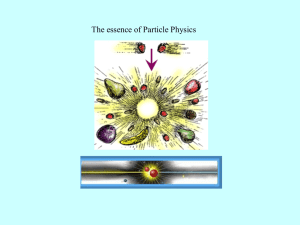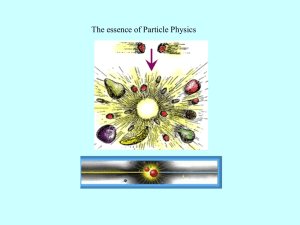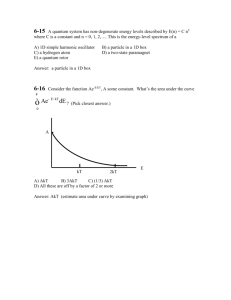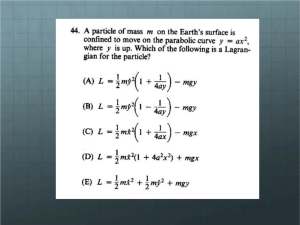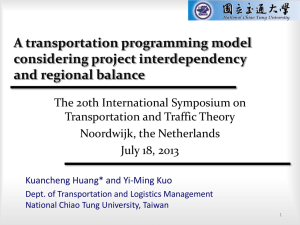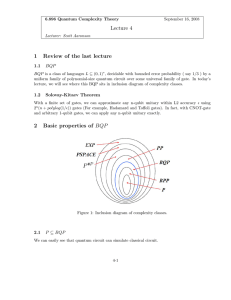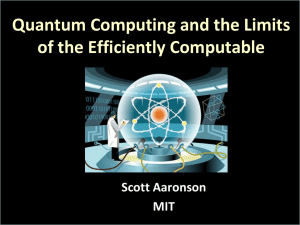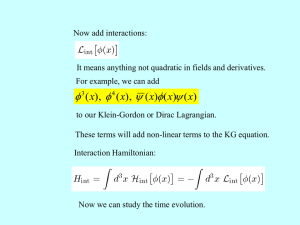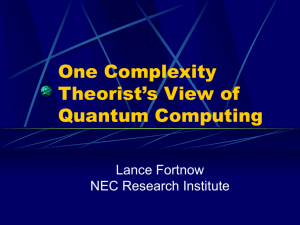hence <
advertisement
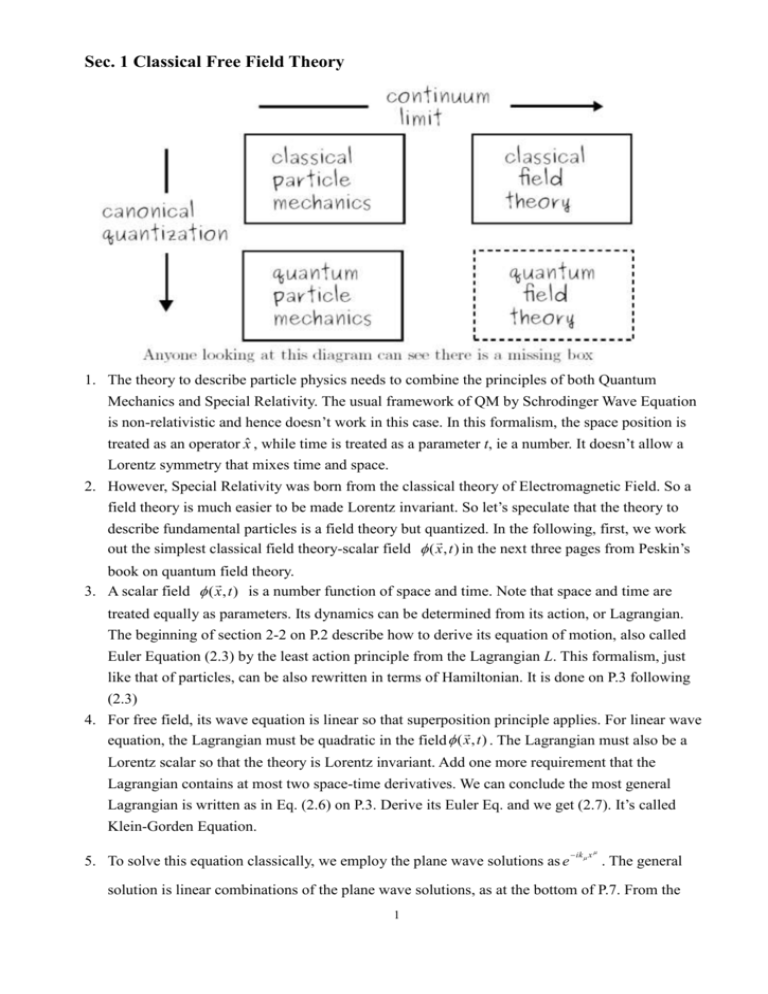
Sec. 1 Classical Free Field Theory 1. The theory to describe particle physics needs to combine the principles of both Quantum Mechanics and Special Relativity. The usual framework of QM by Schrodinger Wave Equation is non-relativistic and hence doesn’t work in this case. In this formalism, the space position is treated as an operator x̂ , while time is treated as a parameter t, ie a number. It doesn’t allow a Lorentz symmetry that mixes time and space. 2. However, Special Relativity was born from the classical theory of Electromagnetic Field. So a field theory is much easier to be made Lorentz invariant. So let’s speculate that the theory to describe fundamental particles is a field theory but quantized. In the following, first, we work out the simplest classical field theory-scalar field ( x , t ) in the next three pages from Peskin’s book on quantum field theory. 3. A scalar field ( x , t ) is a number function of space and time. Note that space and time are treated equally as parameters. Its dynamics can be determined from its action, or Lagrangian. The beginning of section 2-2 on P.2 describe how to derive its equation of motion, also called Euler Equation (2.3) by the least action principle from the Lagrangian L. This formalism, just like that of particles, can be also rewritten in terms of Hamiltonian. It is done on P.3 following (2.3) 4. For free field, its wave equation is linear so that superposition principle applies. For linear wave equation, the Lagrangian must be quadratic in the field ( x , t ) . The Lagrangian must also be a Lorentz scalar so that the theory is Lorentz invariant. Add one more requirement that the Lagrangian contains at most two space-time derivatives. We can conclude the most general Lagrangian is written as in Eq. (2.6) on P.3. Derive its Euler Eq. and we get (2.7). It’s called Klein-Gorden Equation. 5. To solve this equation classically, we employ the plane wave solutions as e ik x . The general solution is linear combinations of the plane wave solutions, as at the bottom of P.7. From the 1 derivation on P.7, you can find the dispersion relation between angular wavenumber k and angular frequency ω or equivalently the relation between momentum and energy. Look it’s exactly the relation for a relativistic particle! This indicate a close relation between particle and field. The strange thing is that there is a positive solution energy plus a negative energy solution. Why it’s so will become clear when the field is quantized. Note that the integration is Lorenz Invariant. The Lorenz invariance of the Lagrangian density will guarantee the Lorenz invariance of Action and hence EOM. 2 3 4 5 6 To solve the KG Equation, we first expand the field in terms of a Fourier Series: The time dependence can be determined by plugging the series into KG Eq. 2 Every Fourier Component behaves like a SHO with ω: p E p p m2 . KG Field is just a collection of SHO’s. Each SHO is characterized by its k or p “momentum”. The frequency ω or “energy” of the SHO is just that of a relativistic particle with mass m. A general solution for the Fourier components is: ( p, t ) a p eiEt c p eiEt . Plugging it into the Fourier expansion we can conclude that the general solution for the KG equation is a linear superposition of plane waves. d3p d3p iEt ip x iEt ip x e ( x) a e c p p 2 3 2 3 d3p d 3 p' iEt ip x a p e c p ' eiEtip ' x 3 3 2 2 Here we changed the variable: p' p . But in the integration, the variable is just a dummy and hence can be renamed as p: ( x) d3p a p e d3p a p e ip x b p e ip x 2 3 2 3 iEt ip x d 3 p' 2 3 b p' e iEtip ' x The solution of KG Equation can be written as: d3p x a p e ip x bp e ip x 3 2 2 with E p p m2 . If the field is real, . Hence bp a p . The real solution of 7 KG Equation can be written as: d3p x a p e ipx a p e ipx 3 2 8 Complex field. Now consider a field which is a complex number: . It’s Lagrangian can be written as: ℒ = (𝜕𝜇 Φ∗ )(𝜕 𝜇 Φ) − 𝑚2 Φ∗ Φ Note that the Lagrangian needs to be real to make the Hamiltoninan real. The physics of this field can be analyzed by looking at its real and imaginary parts: Φ = 𝜙1 +𝑖𝜙2 √2 . By them, the Lagrangian can be written as: 1 1 1 1 (𝜕𝜇 𝜙1 )(𝜕𝜇 𝜙1 ) − 𝑚2 𝜙12 + (𝜕𝜇 𝜙2 )(𝜕𝜇 𝜙2 ) − 𝑚2 𝜙22 2 2 2 2 So the two real fields 𝜙1 , 𝜙2 act separately and both are KG fields. Hence both of them satisfy KG Equation. As a result, the complex field Φ also satisfy KG Equation: ℒ= 2 m2 0 . This equation can also be derived by assuming that Φ and Φ∗ are independent. Note that by ignoring surface terms, the lagrangian can be written in a different form: ℒ = (𝜕𝜇 Φ∗ )(𝜕 𝜇 Φ) − 𝑚2 Φ∗ Φ → −(Φ∗ )(𝜕𝜇 𝜕𝜇 Φ) − 𝑚2 Φ∗ Φ = −(Φ∗ ) ∙ [(𝜕 2 Φ) − 𝑚2 Φ ] Differentiating the Largarngian with respect to Φ∗ gives the KG equation forΦ right away: [(𝜕 2 Φ) − 𝑚2 Φ ] = 0 This equation can solved by the same as the real KG field. However, there are one more degree of freedom and therefore the Fourier expansion of the field contains one more independent coefficient. d3p ( x) (2 ) 3 d3p ( x) (2 ) 3 1 2 1 2 a e ipx p b e ipx p b p e ipx a p e ipx Now we can discuss the symmetry of this model. The free Lagrangian L is invariant under an U(1) phase transformation: ( x) e iQ ( x) since: eiQ eiQ (x) . Here θ is a continuous variable (that’s why this is a U(1)) and Q could be any constant. Phase transformations commute with each other and hence are called Abelian Transformation. The symmetry is even bigger if we consider more than one complex fields. 9 1 2 Assume there are N fields written as a column: 3 n The Lagrangian, as a sum of the KG Lagrangian of all the fields: 𝑛 ℒ = ∑[(𝜕𝜇 Φ𝑖∗ )(𝜕 𝜇 Φ𝑖 ) − 𝑚2 Φ𝑖∗ Φ𝑖 ] ≡ (𝜕𝜇 Φ† )(𝜕 𝜇 Φ) − 𝑚2 Φ† Φ 𝑖=1 is invariant under multiplying the column by a N by N matrix: ( x) U ( x) e i T ( x) i i since 𝛷 † 𝛷 → 𝛷 † 𝑈 † 𝑈𝛷 = 𝛷 † 𝛷. This symmetry is called SU(N). The matrix is special: detU =1. It is unitary: U +U =UU + =1. These matrices do not commute with each other and hence are called Non-Abelian Transformations. Here we have decomposed the matrix U in terms of the exponents of generators U e i T . The two properties imply that the generator matrices satisfy trT = 0 and i i T + = T . For SU(n), there are n 2 -1of n×n generators. For example, for SU(2) the generators are the Pauli Matrices æ ö æ ö æ s 1 = ç 0 1 ÷, s 2 = ç 0 -i ÷, s 3 = ç 1 è 1 0 ø è i You can easily check the free Lagrangian is invariant. 10 0 ø 0 ö ÷ è 0 -1 ø Sec. 2 Quantization of Free Field Theory 1. The Lagrangian form of the classical field theory can be written in Hamiltonian form so that it’s easier to be quantized: 1 1 1 2 H d 3 x 2 m 2 2 2 2 2 2. As explained, field theory is actually a collection of SHOs. Simple harmonic oscillator can be quantized using the raising and lowering operators a and a†: (briefly reviewed on p20 after Eq. (2.22), and certainly explained in your quantum mechanics textbook) a, a 1 1 H aa 2 , n a n 0 3. The scalar field theory could be quantized like in quantum mechanics. It means the fields become operators. For operators, we need to specify their commutation relation. Using Canonical Quantization procedure as in QM: ( x), y i (3) ( x y) 4. The scalar field when Fourier transformed constitutes a series of SHO. And the quantization of scalar field as specified in 3. is equivalent to quantizing the SHO’s: d3p (x) (2 ) 3 a H p 1 2 p a p e ip x a p e ip x 3 , a p ' 2 (3) p p' d3p 2 3 p a p a p 1 a p , a p ' 2 5. The energy eigenstate states can be constructed like in SHO and the energy eigenvalues look exactly like particle states with various particle numbers. This is also true for momentum. See the paragragh after Eq. (2.33) on P. 9. So field, when quantized, become particles. Even better, these are relativistic particles. 11 For field, the space coordinates x correspond to the indices to specify degrees of freedom. So the above commutation relation can be easily generalized to the field operator ϕ(x) and its conjugate momentum π(x): ( x, t ), y, t i (3) ( x y), ( x, t ), y, t 0, ( x, t ), y, t 0 These relations are equivalent to corresponding commutation relations between the a operators. It can be shown that the above relation implies: 3 a p , a p ' 2 3 p p' and vise versa: This is exactly commutation relation of the a operators for a series of quantum simple 12 harmonic oscillator (SHO). For a quantum SHO: The spectrum of SHO is like a ladder. The operator a+ can be used to raise the energy by one quantum while the operator a can be used to lower the energy by one quantum: The operator a+ is called Raising Operator while the operator a Lowering Operator. It has been shown above that Field theory consists of a series of SHO. Hence Quantum Field Theory is just a series of quantum SHO. Now the Hamiltonian of QFT can be written in terms of a’s: 13 d3p We can simply plug in the Fourier Expansion: ( x ) (2 ) 3 1 2 p a p e ip x a p e ip x We can write the Hamiltonian in a form very similar to that of the SHO: Similar commutation relations also apply: To sum up, the spectrum consists of a n p 0 p, n . These states are the eigenstates of the Hamiltonian: H p, n nE p p, n . Note that these relations are a direct copy of those for SHM: Even more striking these states are also eigenstates of momentum density as discussed below. P p, n np p, n 14 15 Complex Field and Antiparticle The above can be easily extended to complex scalar fields. As discussed above, the complex field can be decomposed into the following Fourier components. Note that there are one more degree of freedom per momentum: d3p ( x) (2 ) 3 d3p ( x) (2 ) 3 1 2 1 2 a e ipx p b e p ipx b p e ipx a p e ipx We can also write down the Hamiltonian, Momentum and Conserved Charge in this theory. Written in terms of operators a and b, they could be simplified as: d3 p 2 H=ò p + m 2 × ( a p a+p + bp bp+ ) 3 (2p ) d3p P= ò p × ( a p a+p + bp bp+ ) 3 (2p ) d3p Q= ò a a+ - bp bp+ ) 3( p p (2p ) Note the negative sign in the second term of the expansion of charge Q. It means the particle created by b+ is of the same mass as a+ but contains charge of opposite sign. Hence the particle b+ creates has the same mass but opposite charge. That is, it creates an antiparticle. The new operator bp annihilates an antiparticle with momentum p and bp+ create an antiparticle. This is neat since it means a field Φ will always add charge of one unit (annihilate a particle and create an antiparticle) while its complex conjugate Φ+ will always annihilate charge of one unit (annihilate an antiparticle and create a particle). The charge difference a field operator generates is always the same! 16 Dirac Field 17 18
